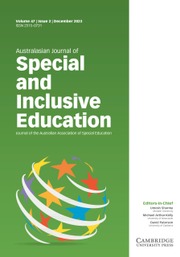No CrossRef data available.
Article contents
Application of an Evidence-Based Early Intervention Model for Children With ASD in Mainstream Early Childhood Education and Care Settings via a Targeted Professional Development Program
Published online by Cambridge University Press: 26 July 2021
Abstract
Viewing all children as active participants in their own learning is central to inclusion. That children with atypical development experience a level of belonging that enables this in mainstream early childhood education and care (ECEC) settings remains a topic of hot debate and very much an unmet goal across the sector. Children with autism spectrum disorder (ASD), in particular, face significant challenges in ECEC settings, their educators continually seeking solutions for greater support. Given the escalating demand on mainstream ECEC settings to include these children, it was important to identify the specific supports needed by educators to achieve this with confidence and competence. This study investigated the outcomes of applying an evidence-based model of intervention to mainstream services via a targeted professional development program. Results of the study found that the benefits of engagement with mainstream ECEC settings extended beyond child outcomes to educators who were supported to develop the knowledge, understanding, and strategies to engage and teach children with ASD and manage their behaviours.
Keywords
Information
- Type
- Original Articles
- Information
- Australasian Journal of Special and Inclusive Education , Volume 45 , Issue 2 , December 2021 , pp. 135 - 149
- Copyright
- © The Author(s), 2021. Published by Cambridge University Press
Footnotes
This manuscript was accepted under the Editorship of Michael Arthur-Kelly.

